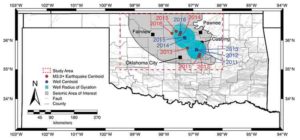
Credit: Pollyea et al. and Geology
Boulder, Colo., USA: In Oklahoma, reducing the amount of saltwater (highly brackish water produced during oil and gas recovery) pumped into the ground seems to be decreasing the number of small fluid-triggered earthquakes. But a new study shows why it wasn’t enough to ease bigger earthquakes. The study, led by Ryan M. Pollyea of Virginia Tech in Blacksburg, Virginia, was published online ahead of print in Geology this week.
Starting around 2009, saltwater disposal (SWD) volume began increasing dramatically as unconventional oil and gas production increased rapidly throughout Oklahoma. As a result, the number of magnitude 3-plus earthquakes rattling the state has jumped from about one per year before 2011 to more than 900 in 2015. “Fluids are basically lubricating existing faults,” Pollyea explains. Oklahoma is now the most seismically active state in the lower 48 United States.
Previous studies linked Oklahoma SWD wells and seismic activity in time. Instead, Pollyea and colleagues studied that correlation in space, analyzing earthquake epicenters and SWD well locations. The team focused on the Arbuckle Group, a porous geologic formation in north-central Oklahoma used extensively for saltwater disposal. The earthquakes originate in the basement rock directly below the Arbuckle, at a depth of 4 to 8 kilometers.
The correlation was clear: “When we plotted the average annual well locations and earthquake epicenters, they moved together in space,” says Pollyea. The researchers also found that SWD volume and earthquake occurrence are spatially correlated up to 125 km. That’s the distance within which there seems to be a connection between injection volume, fluid movement, and earthquake occurrence.
By separating data by year from 2011 through 2016, Pollyea and colleagues also found that the spatial correlation for smaller earthquakes weakened in 2016, when new regulations reduced pumping volumes. Yet the spatial correlation for M3.0+ earthquakes persists unabated. In fact, two particularly alarming earthquakes shook the region in September 2016 and November 2016. The first, M5.8, was the largest ever recorded in Oklahoma. The second, M5.0, rocked the area surrounding the nation’s largest oil storage facility, containing millions of barrels of oil.
Pollyea’s theory for why reduced fluid pressure has only affected small faults: “It’s like the traffic on the freeway is still moving, but the smaller arterials are cut off.” He emphasizes that so far, they can’t predict single earthquakes or even blame specific wells for specific shaking. But to reduce large fluid-triggered earthquakes, Pollyea concludes, “It appears that the way to do it is to inject less water.”
Reference:
Geospatial analysis of Oklahoma (USA) earthquakes (2011-2016): Quantifying the limits of regional-scale earthquake mitigation measures Authors: Ryan M. Pollyea (Virginia Tech; [email protected]); Neda Mohammadi; John E. Taylor; Martin C. Chapman; DOI: 10.1130/G39945.1
Note: The above post is reprinted from materials provided by Geological Society of America.










